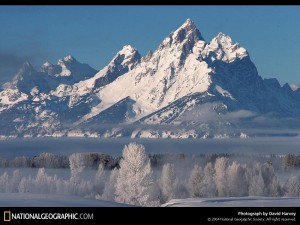 http://photography.nationalgeographic.com/photography/enlarge/grand-teton-national-park_pod_image.html
http://photography.nationalgeographic.com/photography/enlarge/grand-teton-national-park_pod_image.html
Missing Skiers Found After Six-Day Search
On the evening of Saturday, April 23, after a long day of searching an avalanche debris field in Garnet Canyon Meadows, a Grand Teton National Park ranger picked up two discernible beacon signals deep in the snowpack.
Due to the late hour—coupled with the need to evacuate all search teams from the Teton canyon and cease helicopter operations before day’s end—a handful of rescuers were not able to dig deep enough to locate the source of the signals. Early Sunday morning, a core group of park rangers flew back into Garnet Canyon to resume digging. After two hours, they reached Walker Pannell Kuhl and Gregory Seftick, buried under 13 feet of snow near a large boulder in the avalanche path.
Over 35 rescue personnel and four canine teams methodically searched the large avalanche field in Garnet Canyon for more than ten hours on Saturday.
With the help of good weather, rescuers hoped to find any clue as to the fate of Kuhl and Seftick. At 7 p.m. with just two teams left to airlift from the canyon, Ranger Nick Armitage made one final sweep with his avalanche transceiver over an area that had been probed by rescuers earlier in the day. After Armitage picked up first one beacon signal, and then another, five additional rescuers joined in digging through the dense snowpack to reach the source. Although five feet of snow was cleared away, rescuers were not able to reach the beacon before the last helicopter flight needed to be made. Upon removing the snow, however, rescuers also made a positive probe hit. It should be noted that avalanche probe poles are generally 10 feet long and the beacon was deeper than their initial reach.
On Sunday morning, helicopter pilot Nicole Ludwig—flying a Teton County Search and Rescue contract helicopter out of Hillsboro, Oregon—airlifted six park rangers back into the Garnet Canyon Meadows to resume digging toward the two beacons. Rangers continued to excavate through another ten feet of snow before they reached Walker and Greg. Rangers then prepared them for a helicopter flight to the valley floor where a Teton County coroner met the ship.
It appears that Walker and Greg were buried by a large avalanche that shed off the north face of Nez Perce Peak sometime Saturday night, April 16, while they were in their tent, located near a large boulder between the Platforms and the Meadows of Garnet Canyon. Walker and Greg carried avalanche beacons and other appropriate gear with them on their trek into the Teton Range, and their beacons were transmitting when the avalanche enveloped their campsite.
The concentrated search for Kuhl and Seftick lasted six days, due in part to stormy weather, new snowfall and ongoing concerns about avalanche danger for rescue teams. Search operations involved park rangers and staff, as well as numerous Jackson Hole community rescue personnel. Grand Teton National Park appreciates the cooperation and dedication of the organizations and companies who assisted during the past several days.
Those groups include trained rescue personnel, volunteers and support staff from Teton County Search and Rescue, Teton Interagency Fire personnel, Bridger-Teton National Forest and Bridger-Teton National Forest Avalanche Center staff, a Yellowstone National Park employee, Jackson Hole Mountain Resort ski patrol, Wyoming K9 Search and Rescue teams, and Grand Targhee Resort ski patrol and canine teams, as well as experienced professional mountaineers from Jackson Hole Mountain Guides and Exum Mountain Guides.
The Seftick and Kuhl families extend their heartfelt thanks to all rescuers for their work in helping to locate their sons and brothers.


